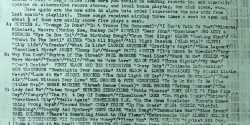A few months ago I wrote about an amazing collection of vintage college radio playlists that were recently sent to me. From the 1970s and 1980s, these playlists were mostly handwritten and typed affairs that were compiled by college radio station music directors.
College radio playlists or airplay reports (as they often included lists of “new adds”) were not only sent to college radio representatives at record labels, but they were also submitted to various organizations and were compiled into college radio charts.
The Intercollegiate Broadcasting System (IBS) had a music industry feature in its Journal of College Radio during that era and regularly published lists of some of the new music being added to college radio stations.
For example, the November, 1970 issue of the Journal of College Radio’s “Music Industry Department” feature included a list of singles, breakouts, and albums that were big in college radio at the time. Jackson Five, Joe Cocker, and the Temptations all had hot singles and the breakouts included Joe Cocker’s “Cry me a River” (at KUGR), Smokey Robinson’s “The Tears of a Clown” (WSAP) and Arlo Guthrie’s “Valley to Pray” (WTGR).
The IBS music feature also included some record reviews and a column opining on the state of music and radio. The November 1970 piece discusses “modern-day underground announcers” who have a much different style on the radio than their more overtly promotional predecessors. The music industry department’s “Disc Notes” column from that issue states, “What is now featured is a slow talking, deliberate person who talks about the music he is playing and talks directly to the individual listener.”
Interestingly, that same issue had the lengthy article, “College Radio: What to do Now!” by Mercury Records’ Promotion Director John Sippel. He talks about the importance of college radio to the music industry and oddly enough, he came to an epiphany about that because of Serge Gainsbourg.
Sippel writes, “…it took a French import single, Je T’aime by Jane Birkin and Serge Gainsbourg, to forcibly bring the college broadcaster to my attention, and, I’m certain, to many more of my record business contemporaries. Without a doubt, a very few commercial AM and FM stations did play the record, but, in most cases, that demand on that commercial outlet was precipitated by a consistent play on the part of the collegiate station in the area, before the commercial broadcaster programmed it.”
He goes on to call for college radio to “centralize its reporting of listeners’ preferred records” and cites the Journal of College Radio, as well as various individuals (including Bill Gavin) and trade papers in the hopes that someone would “weekly tabulate the tops in college LP and single requests.” He also encourages college radio stations to publish and send out playlists. Sippel advises, “Publish a Top 40 sheet that zings with graphic appeal. Distribute it to every source where it will do you good. Work IBS, a radio rating sheet or a trade paper to establish your own national college radio sheet.” He closes with the bold statement, “Let historians of modern communications report in the future that the 1970-71 school session marked the time when College Radio became the factor in creating and reporting important trends.”
Today, this playlist reporting tradition continues with CMJ, which not only compiles weekly charts based on information sent in from college radio station reporters, but also publishes charts from individual stations for its subscribers.
A version of this piece originally appeared in the May 28, 2015 Radio Survivor Bulletin. Subscribe to the free weekly Bulletin here in order to get more exclusive content like this every week.



